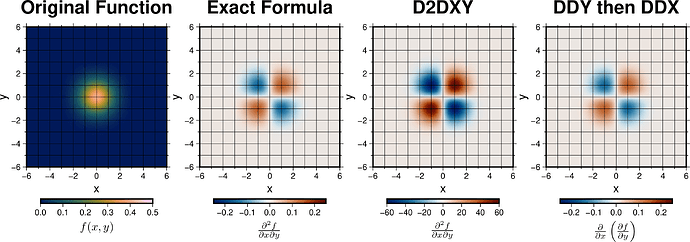Hi, long-time user, first time poster here. Thanks to the GMT developers for all their effort on the software and also to this wonderful community that we have in the forum.
I just wanted to check whether the output of the D2DXY operator in grdmath is as intended. To demonstrate, I am including the following example script for a Gaussian function:
gmt begin gaussian_test_diff png
# generate grid representation of a Gaussian function
gmt grdmath -R-6.0/6.0/-6.0/6.0 -I0.05 2.0 PI MUL SQRT INV STO@nc POP \
X Y HYPOT DUP MUL 2.0 DIV NEG EXP @nc MUL CLR@nc = gaussfunc.nc
# generate meshes for the x and y coordinates
gmt grdmath -R-6.0/6.0/-6.0/6.0 -I0.05 X = mesh_x.nc
gmt grdmath -R-6.0/6.0/-6.0/6.0 -I0.05 Y = mesh_y.nc
# exact solution for the derivative
gmt grdmath gaussfunc.nc mesh_x.nc MUL mesh_y.nc MUL = d2gaussdxdy_ex.nc
# compute derivative using the D2DXY operator
gmt grdmath gaussfunc.nc D2DXY = gauss_d2dxy.nc
# compute derivative using DDY and then DDX
gmt grdmath gaussfunc.nc DDY DDX = gauss_ddx_ddy.nc
# plot
gmt subplot begin 1x4 -Fs6c -C0.25c
gmt subplot 0,0
gmt makecpt -Cbatlow -T0.0/0.5/0.01 -Z
gmt grdimage gaussfunc.nc -Ba2f1g1 -BWeSn+t"Original Function" -Bx+l"x" -By+l"y"
gmt colorbar -DJBC+o0c/1.25c+h -Ba0.1+l"@[ f(x,y) @[ "
gmt subplot 0,1
gmt makecpt -Cvik -T-0.25/0.25/0.01 -Z
gmt grdimage d2gaussdxdy_ex.nc -Ba2f1g1 -BWeSn+t"Exact Formula" -Bx+l"x" -By+l"y"
gmt colorbar -DJBC+o0c/1.25c+h -Ba0.1+l"@[ \frac{\partial^2 f}{\partial x \partial y} @[ "
gmt subplot 0,2
gmt makecpt -Cvik -T-60/60/5 -Z
gmt grdimage gauss_d2dxy.nc -Ba2f1g1 -BWeSn+t"D2DXY" -Bx+l"x" -By+l"y"
gmt colorbar -DJBC+o0c/1.25c+h -Ba20+l"@[ \frac{\partial^2 f}{\partial x \partial y} @[ "
gmt subplot 0,3
gmt makecpt -Cvik -T-0.25/0.25/0.01 -Z
gmt grdimage gauss_ddx_ddy.nc -Ba2f1g1 -BWeSn+t"DDY then DDX" -Bx+l"x" -By+l"y"
gmt colorbar -DJBC+o0c/1.25c+h -Ba0.1+l"@[ \frac{\partial }{\partial x } \left( \frac{\partial f}{\partial y} \right) @[ "
gmt subplot end
gmt end show
I am also including the PNG file generated by the above script. The issue as I see it is that the values of the second partial derivative with respect to both x and y as computed by the D2DXY operator don’t seem to correspond with the exact formula (note the different ranges of the colorbars). However, applying the operators DDY then DDX seems to approximate the expected result.
I guess I was expecting all three approaches above to be equivalent within the numerical accuracy for computing derivatives using finite differences, so I am wondering whether the output from D2DXY is supposed to have these values.
Thanks for reading!
Cheers,
Soli


